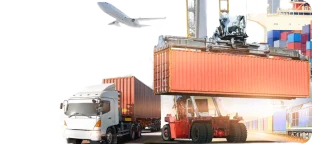
Multimodal Transportation Companies



















Multimodal transportation refers to freight services that involve delivering goods using two or more types of transport, such as trucks and trains, along a pre-planned route. In this case, the customer can enter into a contract with one or multiple companies. For example, they might entrust rail transport to one company, road transport to another, and so on.
Companies specializing in multimodal transportation often use containers to move cargo. These containers can be easily transferred from one mode of transport to another, saving time on loading and unloading operations. Standard-sized containers can be loaded onto container ships, trains, vessels, and airplanes.
The combination of different types of transport allows for the shipment of virtually all types of cargo, such as oversized and hazardous goods. Much depends on the resources of the contractor with whom the client signs the contract.
Popular types of shipments include:
- food products and agricultural goods;
- lumber and wood processing products;
- bulk construction materials and crushed rocks;
- fertilizers and pesticides;
- home appliances and electronics;
- metallurgical products;
- consumer goods — clothing, footwear, household chemicals, and others.
Companies providing multimodal transportation often have access to vehicles with varying load capacities and specialized equipment. For example, they may not have trucks (semis) or refrigerated containers required for transporting perishable goods. Therefore, it is advisable to discuss the details of the shipment with a potential partner in advance.
Multimodal freight transportation involves the combination of several modes of transport. During delivery, the following methods may be used:
- Air freight. One of the fastest and most expensive ways to deliver various goods — from food products to cars and heavy machinery, depending on the cargo capacity of a specific aircraft. This method is relevant for intercontinental shipments.
- Waterborne transport. Used for delivering heavy and oversized items over long distances. Marine multimodal shipping is cheaper than air freight but takes longer.
- Rail transport. Carried out using trains and suitable for shipping large and heavy items, including bulk and liquid materials.
- Road transport. A popular method that uses trucks of varying capacities for delivery.
Each method has its own specific advantages. For example, air freight is distinguished by its speed, rail transport by its cost-effectiveness, and road transport by its geographical accessibility.
Contractors typically offer unified rates for freight transportation, which often helps save on shipping costs. All stages of delivery are covered by a single document — the multimodal bill of lading, which ensures full cargo tracking throughout the journey.
Other important features of this delivery method include:
- issuance of a single transport documentation;
- use of vehicles from one or multiple carriers;
- minimization of the risk of transportation cost increases after the contract is signed;
- convenient cooperation with a single contractor;
- more efficient logistics with minimal involvement of the shipper and consignee in the transportation process.
Companies providing multimodal transportation are also responsible for ensuring the safety of the cargo. In case of damage or loss, the shipper does not need to file claims with multiple carriers who might try to shift responsibility onto another subcontractor.
Important: The company with which the contract is signed may engage subcontractors. However, these processes do not affect the customer — the carrier with whom the contract was signed remains fully responsible for the shipment.
Each company has its own specific advantages and disadvantages, but there are general benefits that characterize multimodal freight transport:
- Cost reduction. The contractor can select a cost-effective mode of transport, ultimately lowering the shipping expenses.
- Shorter delivery times. If the customer aims for the fastest possible delivery, the carrier designs a route and selects suitable modes of transport within the established budget.
- Convenience. The ability to use multiple modes of transport makes the service geographically accessible — the contractor can deliver goods even to the most remote regions and countries.
- Reliability. The shipper is protected by a contract — in case of non-performance, the customer can claim all losses from the contractor through the claims process or via legal action.
- Route optimization. The ability to choose the best transport options for each stage of delivery helps reduce overall transit time and improve transportation efficiency.
- Cost optimization. The customer can balance expenses and meet required timeframes by combining cost-effective and faster modes of transport.
- Flexibility and accessibility. Combining various modes of transport allows goods to be delivered to almost any region, including hard-to-reach locations.
- Time savings. Using different transport methods can speed up delivery, even with strict budget constraints.
- Environmental friendliness. Customers can choose the most environmentally safe modes of transport, such as rail or sea, reducing the carbon footprint of each shipment.
- Simplified customs procedures. Specialists from multimodal transport operators often have extensive experience navigating customs processes, speeding up clearance and minimizing delays at borders.
Distributing the load across different modes of transport can enhance the overall logistics system, avoiding overloading specific parts of the network.
Prices are often calculated upon request and are primarily influenced by the route, type and quantity of cargo, delivery speed requirements, and the need for additional documentation. For example, international shipments require customs clearance and potential border delays, which can increase costs.
Multimodal freight transport involves the use of various types of transportation, each with its own specific cost structure. Rail and road transport are generally cheaper than air freight. However, air transport is indispensable when there is a need for rapid delivery over long distances.
💡 Customers can use the functionality of a freight exchange platform to compare prices and find competitive rates. On the Roolz platform, you can also conduct auctions to receive offers from transportation companies and private carriers.
In the interest of the shipper, it is important to select a reliable contractor who provides maximum guarantees. Here are the key criteria for selection:
- Rating and reputation — It is recommended to check the counterparty, analyze customer reviews, and review the information in their profile.
- Customer support — Clarify in advance whether you will be kept informed about the delivery status and who will address any potential issues.
- Cost — Companies with similar resources often offer different prices for their services, so it’s worth comparing them to choose the most cost-effective option.
- Terms — Ideally, the contractor should handle all aspects of transportation, including customs clearance and storage.
- Safety — Request a draft contract from your partner. Review it to ensure the company takes responsibility for the safety of the cargo and commits to delivering it to the consignee on time according to the agreed terms.
Multimodal transport involves using multiple modes of transport and, if necessary, conducting additional loading and unloading operations. It is crucial that the contractor ensures cargo safety at every stage of the journey.
Finding a logistics partner is easy through the Roolz platform, where you can find offers from transportation and forwarding companies specializing in multimodal shipping.
What is multimodal freight transportation?
Multimodal transportation refers to freight services that involve delivering goods using two or more types of transport, such as trucks and trains, along a pre-planned route. In this case, the customer can enter into a contract with one or multiple companies. For example, they might entrust rail transport to one company, road transport to another, and so on.
Companies specializing in multimodal transportation often use containers to move cargo. These containers can be easily transferred from one mode of transport to another, saving time on loading and unloading operations. Standard-sized containers can be loaded onto container ships, trains, vessels, and airplanes.




Add your company


 en
en fr
fr de
de hi
hi pl
pl es
es tr
tr uk
uk